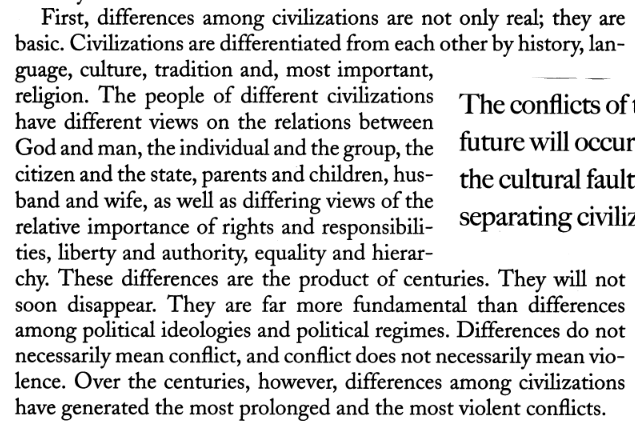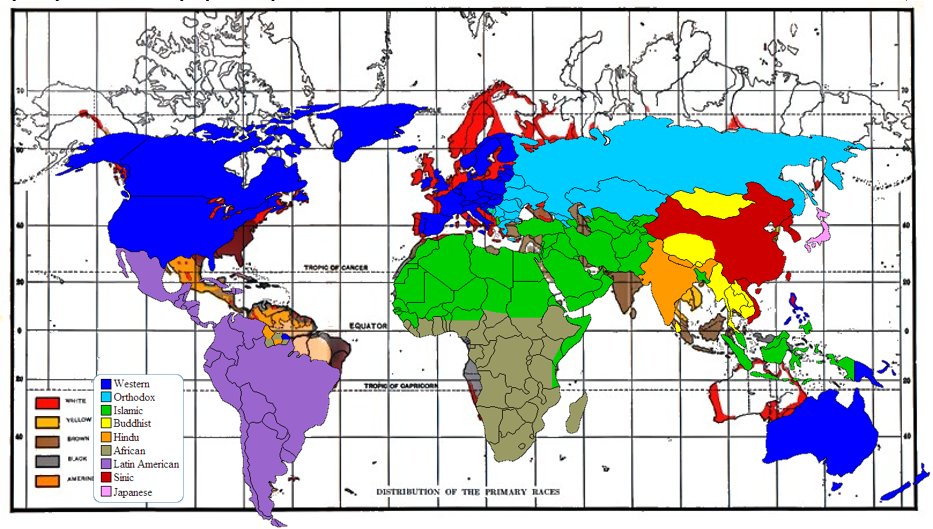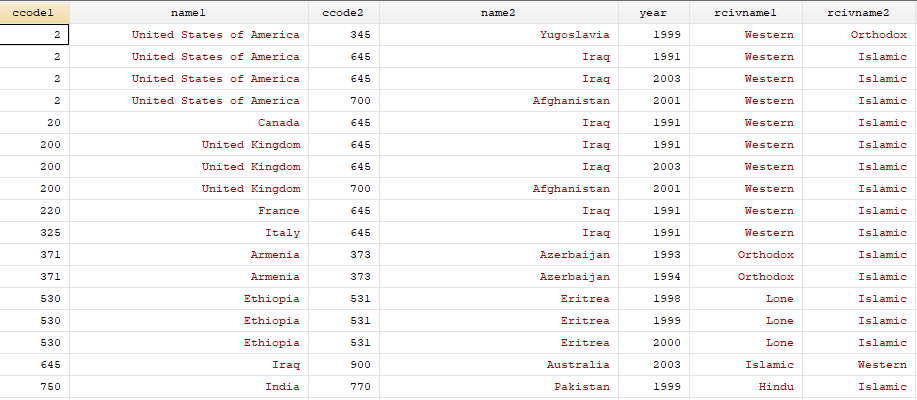I did it -- I taught "Clash of Civilizations" to my "Intro to IR" students.
How did I do it? How did it go?
[THREAD]
How did I do it? How did it go?
[THREAD]
First, I had them read Huntington& #39;s 1993 @ForeignAffairs piece https://www.foreignaffairs.com/articles/united-states/1993-06-01/clash-civilizations">https://www.foreignaffairs.com/articles/...
Second, I posed the question: "Should We Study Clash?"
I made them aware of the debate over teaching this piece in the classroom. Specifically, I introduced them to the @HDiplo teaching roundtable headed up by @profmusgrave
https://networks.h-net.org/node/28443/discussions/5273269/h-diploissf-teaching-roundtable-11-6-clash-civilizations-ir">https://networks.h-net.org/node/2844...
https://networks.h-net.org/node/28443/discussions/5273269/h-diploissf-teaching-roundtable-11-6-clash-civilizations-ir">https://networks.h-net.org/node/2844...
I showed the students the beyond ridiculous number of citations for the piece
https://scholar.google.com/scholar?hl=en&as_sdt=0%2C14&q=Clash+of+Civilizations&oq=Clash">https://scholar.google.com/scholar...
https://scholar.google.com/scholar?hl=en&as_sdt=0%2C14&q=Clash+of+Civilizations&oq=Clash">https://scholar.google.com/scholar...
I showed them various examples of how this idea has found its way into policy (h/t @monkeycageblog & @Steven_m_ward)... https://www.washingtonpost.com/politics/2019/05/04/because-china-isnt-caucasian-us-is-planning-clash-civilizations-that-could-be-dangerous/">https://www.washingtonpost.com/politics/...
....and media https://www.washingtonexaminer.com/weekly-standard/the-gathering-storm-1689">https://www.washingtonexaminer.com/weekly-st...
In short, I said, "Maybe this is a dangerous idea. But it& #39;s sufficiently prominent that you are likely to hear it at some point. Plus, at @UChicago we don& #39;t shy away from an idea, even if it& #39;s dangerous. We engage it and see if there is any `there, there& #39;".
Third, I posed the question: "What is Clash?"
This meant going through key passages of Huntington& #39;s 1993 piece, namely this paragraph...
Fourth, I posed the question: "How Do We Measure Clash?"
Specifically, I showed Huntington& #39;s map....which immediately raised some skeptical looks  https://abs.twimg.com/emoji/v2/... draggable="false" alt="🤨" title="Face with raised eyebrow" aria-label="Emoji: Face with raised eyebrow">
https://abs.twimg.com/emoji/v2/... draggable="false" alt="🤨" title="Face with raised eyebrow" aria-label="Emoji: Face with raised eyebrow">
Then I took them through the various maps, trying to figure out from where he identified his civilizations. Basically walked them through the maps found in this @lefarkins piece by @dhnexon (which are drawn from a twitter thread of mine) http://www.lawyersgunsmoneyblog.com/2019/05/a-better-reading-of-history-must-bring-home-the-truth-that-the-basic-factor-in-human-affairs-is-not-politics-but-race">https://www.lawyersgunsmoneyblog.com/2019/05/a...
I super-imposed Huntington& #39;s map. Students made the connection
Fifth, I posed the question: "How Do We Test Clash?"
Note: I added that while Huntington maybe doesn& #39;t deserve a benefit of a doubt, let& #39;s give him one for the sake of seeing if there is a `there, there& #39;"
Note: I added that while Huntington maybe doesn& #39;t deserve a benefit of a doubt, let& #39;s give him one for the sake of seeing if there is a `there, there& #39;"
This largely entailed walking them through the pieces in this thread from earlier in the year https://twitter.com/ProfPaulPoast/status/1123959166551326722">https://twitter.com/ProfPaulP...
We spent a lot of time on the Oneal, Russett, and Cox @JPR_journal piece... https://journals.sagepub.com/doi/abs/10.1177/0022343300037005003">https://journals.sagepub.com/doi/abs/1...
....Huntington& #39;s rebuttal... https://journals.sagepub.com/doi/abs/10.1177/0022343300037005004">https://journals.sagepub.com/doi/abs/1...
...the response by Russett & Oneal... https://journals.sagepub.com/doi/abs/10.1177/0022343300037005005">https://journals.sagepub.com/doi/abs/1...
....and the followup by Nicholas Charron in Cooperation and Conflict https://journals.sagepub.com/doi/abs/10.1177/0010836709347215">https://journals.sagepub.com/doi/abs/1...
Finally, we evaluated it ourselves!
-- We used MID data from COW
-- Civilization codings from the data provided by Giacomo Chiozza in his @JPR_journal piece (which I updated to the present) https://journals.sagepub.com/doi/10.1177/0022343302039006004">https://journals.sagepub.com/doi/10.11...
-- We used MID data from COW
-- Civilization codings from the data provided by Giacomo Chiozza in his @JPR_journal piece (which I updated to the present) https://journals.sagepub.com/doi/10.1177/0022343302039006004">https://journals.sagepub.com/doi/10.11...
Overall, we had data from 1990 to 2010 -- the post-Cold War time period that Huntington said is appropriate for testing his theory.
What did we find?
What did we find?
We found the following "intercivilizational dyads" had wars between 1990-2010. I& #39;m not sure Persian Gulf 1991, Kosovo 1999, Iraq 2003, Eritrea-Ethiopia, & Armenia-Azerbaijan were driven by "civilizational differences"  https://abs.twimg.com/emoji/v2/... draggable="false" alt="🤔" title="Thinking face" aria-label="Emoji: Thinking face">
https://abs.twimg.com/emoji/v2/... draggable="false" alt="🤔" title="Thinking face" aria-label="Emoji: Thinking face">
Same for Afghanistan in 2001, but I could see a debate
Same for Afghanistan in 2001, but I could see a debate
The students found this all SUPER interesting. I had a lot of questions after class (as did my TAs).
Students weren& #39;t buying the theory, but they agreed that it is "seductively simple". That is likely why it sticks around...and why it should be engaged in IR classrooms.
[END]
Students weren& #39;t buying the theory, but they agreed that it is "seductively simple". That is likely why it sticks around...and why it should be engaged in IR classrooms.
[END]

 Read on Twitter
Read on Twitter



 " title="Specifically, I showed Huntington& #39;s map....which immediately raised some skeptical looks https://abs.twimg.com/emoji/v2/... draggable="false" alt="🤨" title="Face with raised eyebrow" aria-label="Emoji: Face with raised eyebrow">" class="img-responsive" style="max-width:100%;"/>
" title="Specifically, I showed Huntington& #39;s map....which immediately raised some skeptical looks https://abs.twimg.com/emoji/v2/... draggable="false" alt="🤨" title="Face with raised eyebrow" aria-label="Emoji: Face with raised eyebrow">" class="img-responsive" style="max-width:100%;"/>


 Same for Afghanistan in 2001, but I could see a debate" title="We found the following "intercivilizational dyads" had wars between 1990-2010. I& #39;m not sure Persian Gulf 1991, Kosovo 1999, Iraq 2003, Eritrea-Ethiopia, & Armenia-Azerbaijan were driven by "civilizational differences" https://abs.twimg.com/emoji/v2/... draggable="false" alt="🤔" title="Thinking face" aria-label="Emoji: Thinking face">Same for Afghanistan in 2001, but I could see a debate" class="img-responsive" style="max-width:100%;"/>
Same for Afghanistan in 2001, but I could see a debate" title="We found the following "intercivilizational dyads" had wars between 1990-2010. I& #39;m not sure Persian Gulf 1991, Kosovo 1999, Iraq 2003, Eritrea-Ethiopia, & Armenia-Azerbaijan were driven by "civilizational differences" https://abs.twimg.com/emoji/v2/... draggable="false" alt="🤔" title="Thinking face" aria-label="Emoji: Thinking face">Same for Afghanistan in 2001, but I could see a debate" class="img-responsive" style="max-width:100%;"/>


